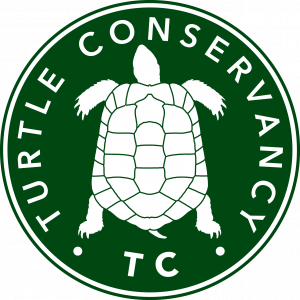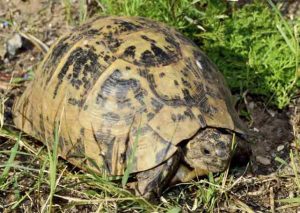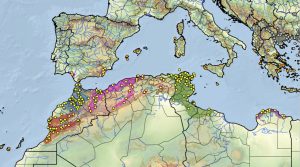Testudo graeca (Western Subspecies Clade), 117
Testudo graeca Linnaeus 1758 (Western Subspecies Clade:
Testudo g. graeca, T. g. cyrenaica, T. g. marokkensis, T. g. nabeulensis, T. g. whitei) –
Mediterranean Spur-thighed Tortoise, Moorish Tortoise, Libyan Tortoise,
Moroccan Tortoise, Tunisian Tortoise, Souss Valley Tortoise
Daniel Escoriza1, Carmen Díaz-Paniagua2, Ana Andreu2, and Jihène Ben Hassine3
1Grup de Recerca en Ecologia Aquàtica Continental (GRECO, University of Girona,
Campus Montilivi, 17071 Girona, Spain [[email protected]];
2Estación Biológica de Doñana-CSIC, 41092 Sevilla, Spain [[email protected]; [email protected]];
3University Tunis El Manar, Tunis, Tunisia [[email protected]]
Summary. − The western subspecies clade of the Mediterranean Spur-thighed Tortoise, Testudo graeca (Family Testudinidae) is comprised of small to medium-sized subspecies (maximum straight carapace lengths [SCL] <25 cm) native to northern Africa and southwestern Europe. In North Africa, Testudo graeca occurs in Mediterranean climates from humid to arid. In the Iberian Peninsula, it is restricted to subhumid, semi-arid, and arid regions. In North Africa, it reaches an altitude of 2090 m in the Haut Atlas (Morocco); in the Iberian Peninsula, it occurs at low elevations below 500 m. Testudo graeca is characterized by the presence of two spurs on the thighs, which are present in all subspecies except in 23% of specimens of T. graeca graeca. Adult females are on average larger (mean SCL = 15.5 cm, males mean SCL = 13.5 cm) and heavier than males (females mean body mass = 689 g, males mean body mass = 442 g). Females have proportionately shorter tails than males. Females produce 1–4 clutches of 1–8 eggs annually between April and July. The annual survival rate of adults is very high; it is estimated at over 90% in southern Spain. Population stability depends mainly on adult survival. The species is still relatively common and widespread in much of North Africa. However, European populations are endangered and in steep decline. In North Africa, the main threats to T. graeca are illegal collection for domestic and some international trade, degradation of habitats by overgrazing, and urbanization. In Europe, populations are threatened by habitat loss and fragmentation of populations. In Northern Africa and southwestern Europe, there is a strong tradition of collecting individuals to be kept in gardens. In Mallorca and southeastern Spain, several captive breeding projects are being carried out to reintroduce specimens in regions where the species has been extirpated.
Distribution. − Algeria, Libya, Morocco, Spain, and Tunisia. Introduced since historic times in the Balearic islands of Spain and western Sardinia, Italy.
Synonymy. – Testudo graeca Linnaeus 1758, Testudo graeca graeca, Peltastes graecus, Testudo pusilla Linnaeus 1758, Chersine pusilla, Testudo mauritanica Duméril and Bibron 1835, Testudo graeca mauritanica, Chersus mauritanicus, Peltastes mauritanicus, Testudo ibera mauritanica, Testudo flavominimaralis Highfield and Martin 1989, Testudo graeca flavominimaralis, Furculachelys nabeulensis Highfield 1990, Testudo nabeulensis, Testudo graeca soussensis Pieh 2001, Testudo soussensis, Testudo (Testudo) graeca soussensis, Testudo graeca lamberti Pieh and Perälä 2004.
Subspecies. − Based on molecular analyses, five subspecies are currently recognized in the western clade of the Mediterranean Spur-thighed Tortoise: T. graeca graeca (southwestern Morocco, previously referred to as T. graeca soussensis), T. graeca cyrenaica (northeastern Libya), T. graeca marokkensis (northern and central Atlantic plain of Morocco), T. graeca nabeulensis (Tunisia, extreme northeastern Algeria, northwestern Libya, introduced in Sardinia) and T. graeca whitei (northeastern Morocco, western Algeria, peninsular Spain, introduced in Mallorca and Formentera, previously referred to as T. graeca graeca).
Status. − IUCN 2021 Red List: Vulnerable (VU A1cd, assessed 1996); Regional (Europe): Vulnerable (VU A2bcde+4bcde, assessed 2009); CITES: Appendix II; EU: Annex A (regulation of trade of fauna and flora); Bern Convention: Annex II.
Citation:
Escoriza, D., Díaz-Paniagua, C., Andreu, A., and Ben Hassine, J. 2022. Testudo graeca Linnaeus 1758 (Western Subspecies Clade: Testudo g. graeca, T. g. cyrenaica, T. g. marokkensis, T. g. nabeulensis, T. g. whitei) – Mediterranean Spur-thighed Tortoise, Moorish Tortoise, Libyan Tortoise, Moroccan Tortoise, Tunisian Tortoise, Souss Valley Tortoise. In: Rhodin, A.G.J., Iverson, J.B., van Dijk, P.P., Stanford, C.B., Goode, E.V., Buhlmann, K.A., and Mittermeier, R.A. (Eds.). Conservation Biology of Freshwater Turtles and Tortoises: A Compilation Project of the IUCN/SSC Tortoise and Freshwater Turtle Specialist Group. Chelonian Research Monographs 5(16):117.1–18. doi: 10.3854/crm.5.117.western.graeca.v1.2022; www.iucn-tftsg.org/cbftt/.
Adobe Acrobat 6.0 or later required)
Testudo graeca graeca from Essaouira, southwestern Morocco.
Photo by Daniel Escoriza
Distribution:
Distribution of the western subspecies clade of Testudo graeca in southwestern Europe (Spain) and northwestern Africa (Algeria, Libya, Morocco, Tunisia). Yellow dots = museum and literature occurrence records of native populations based on Iverson (1992), other more recent literature sources (see TTWG 2017, 2021), and authors’ data; orange dots = introduced or historically relict populations or individual trade specimens; gray dots and gray shading = western extent of the eastern subspecies clade of T. graeca (= T. g. ibera); colored shading = presumed historic indigenous ranges of: 1) T. g. graeca (formerly referred to T. g. soussensis) = red; 2) T. g. cyrenaica = purple; 3) T. g. marokkensis = blue; 4) T. g. nabeulensis = green; and 5) T. g. whitei (formerly referred to T. g. graeca) = pink. Distribution based on GIS-defined level 12 HUCs (hydrologic unit compartments) constructed around verified localities and then adding HUCs that connect known point localities in the same watershed or physiographic region, and similar habitats and elevations as verified HUCs (Buhlmann et al. 2009; TTWG 2017, 2021), and adjusted based on data from authors’ and other sources.










